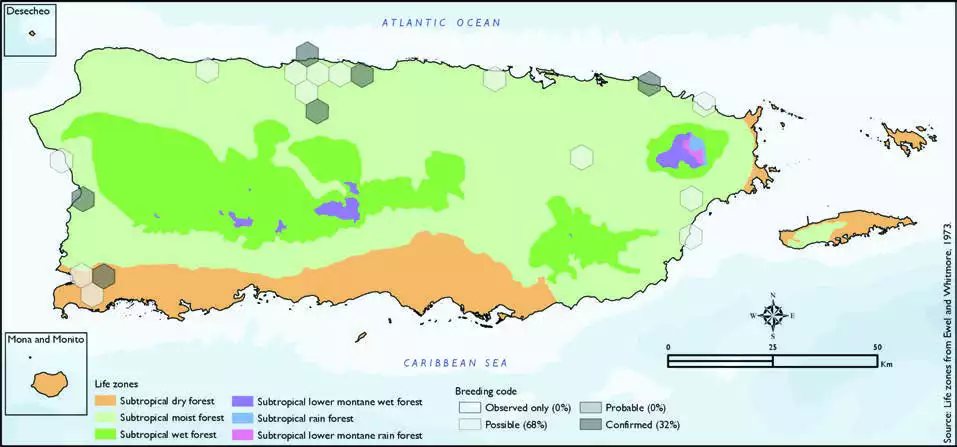Purple Gallinule
Distribution & Habitat
The Purple Gallinule occurs from the United States through Central
and South America including
the West Indies (Raffaele and
others 1998). In addition, it also
occurs in The Bahamas but to a
lesser extent (Raffaele and others
1998). In Puerto Rico, it is an
uncommon to rare resident in
coastal wetlands (Oberle 2018,
Raffaele 1989a) and can be seen
regularly in the Humacao Natural
Reserve, and Caño Tiburones
Natural Reserve (Oberle 2018),
but it can also be found at Las
Cucharillas marsh in Cataño and
the Boquerón Wildlife Refuge (PRDNER 2015). The species
presence is unconfirmed on
Vieques (Gemmill 2015). Habitat
includes rice fields along with
freshwater marshes, swamps,
and ponds with emergent dense
vegetation (Oberle 2018, Raffaele
and others 1998). The atlas
fieldwork yielded a total of 40
records within 19 hexagons or 4
percent of the 479 total hexagons
(see map). Of the 19 hexagons
where this species was found,
breeding met the atlas definition
of confirmed in 32 percent (6) of
the hexagons and possible in 68
percent (13) (see map). Purple Gallinule distribution. The map shows the highest breeding code by hexagon and overlaying the ecological life zones in
Puerto Rico. Note: percentages may not total 100 due to rounding. 95Purple Gallinule/Gallareta Azul

Breeding Habits
Previously published reports indicate that the Purple Gallinule
breeds primarily from July to
September (Raffaele and others
1998). The nest is usually built
among cattails or rice grass
(Raffaele and others 1998). Atlas
results suggest that this species
breeds throughout the year with
the most breeding activity during
March (see chart). Overall, the
breeding activity mostly takes
place in the lowlands within the
subtropical moist forest life zone (84 percent of the hexagons)
(see table and map). However,
results indicate that it also breeds
within the subtropical dry forest
life zone (16 percent of the
hexagons) (see table and map).
Conservation
The current population trend of the Purple Gallinule is
described as decreasing. In
North America, the population
trend is decreasing (Butcher
and Niven 2007), although
populations are stable elsewhere (Wetlands International 2012).
This species is currently listed
as a species of least concern by
the IUCN (BirdLife International
2016). Locally, this species is not
listed in any of the threatened
categories of PRDNER and
USFWS. In Puerto Rico, the
Purple Gallinule has a protected
habitat in land of 16 percent or
71 km2 of the total area covered by the hexagons where evidence
of breeding was found for this
species (454 km2).
Related Species
Family:
rail